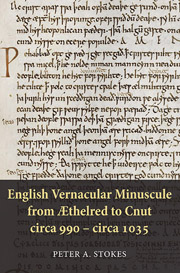Book contents
- Frontmatter
- Contents
- Lists of Tables
- Lists of Figures
- Lists of Plates
- Acknowledgements
- List of Abbreviations
- Introduction
- 1 Background
- 2 Attributions of Origin
- 3 Scribal Change in Bookhands and Charters: The ‘Tall and Narrow’ Hands
- 4 Scribal Continuity in Bookhands and Charters: The ‘Square-Influenced’ Hands
- 5 Glosses and Scribbles
- Conclusion: Change and Continuity in Early English Vernacular Minuscule
- Appendix. List of Scribal Hands
- Glossary
- Bibliography
- Index of Manuscripts and Charters
- General Index
- Plate section
4 - Scribal Continuity in Bookhands and Charters: The ‘Square-Influenced’ Hands
Published online by Cambridge University Press: 05 April 2014
- Frontmatter
- Contents
- Lists of Tables
- Lists of Figures
- Lists of Plates
- Acknowledgements
- List of Abbreviations
- Introduction
- 1 Background
- 2 Attributions of Origin
- 3 Scribal Change in Bookhands and Charters: The ‘Tall and Narrow’ Hands
- 4 Scribal Continuity in Bookhands and Charters: The ‘Square-Influenced’ Hands
- 5 Glosses and Scribbles
- Conclusion: Change and Continuity in Early English Vernacular Minuscule
- Appendix. List of Scribal Hands
- Glossary
- Bibliography
- Index of Manuscripts and Charters
- General Index
- Plate section
Summary
As I have shown in the previous chapter, the last decade of the tenth century saw a new style of script develop, which I have called Style-I English Vernacular minuscule. However, this script was not practised throughout Anglo-Saxon England. Instead, some scribes seemed to have written a second style of Vernacular minuscule, one which preserved more features of Square minuscule, particularly the proportions and quite a few of the letter-forms. These are largely the hands which Neil Ker described as ‘late forms of’ or ‘manifest descendants of’ Square minuscule, and they are the hands which will be considered in detail here. Care must be taken in such a consideration, as the presence of features from Square minuscule in some houses may be due to simple conservatism or isolation from new developments rather than the deliberate adoption of a new style which happened to retain these features. Nevertheless, the evidence strongly suggests that some scribes did indeed adopt a new style of writing closely related to, but distinct from, English Square minuscule. And some, though not all, of these scribes can be attributed to Canterbury or its cultural orbit.
Canterbury and its Orbit
Christ Church Cathedral
The surviving manuscripts from Canterbury Cathedral from the late tenth century seem to have been written either in Anglo-Caroline or in Phase-V Square minuscule and its immediate descendants. Despite the introduction of Caroline script by the second half of the tenth century, high-grade liturgical books produced at Canterbury were written in Phase-V Square minuscule and are therefore atypical of this period.
- Type
- Chapter
- Information
- Publisher: Boydell & BrewerPrint publication year: 2014



